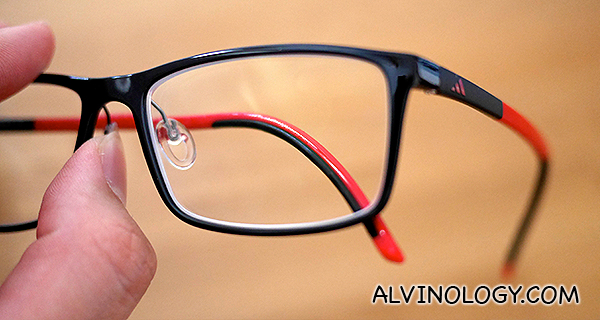To usher in the new year, I made myself a new pair of spectacles, fitted with Crizal UV lens, developed by Essilor:

Crizal lens’ main selling proposition is it’s claims to eliminate all the five enemies of clear vision, namely reflections, scratches, smudges, water and dust, while enabling the wearer to maintain a pleasant disposition. I covered these in a previous blog post.
Now, Crizal UV lens come equipped with Eye- Sun Protection Factor (E-SPF) 25, meaning the wearer is 25 times more protected against ultraviolet (UV) rays than without any lens.
The lens are clear:

If you are also making a pair of new spectacles for the new year, why not consider fitting clear Crizal UV lens?
Dark tinted sunglasses do not necessarily block out UV rays better than light tinted lens. Yet more than half (52 per cent) of the respondents did not get the correct answer in a recent online survey conducted by Essilor among 750 Singapore Citizens and Permanent Residents aged 18 years old and above.
The survey also revealed that nearly half (48 per cent) of the respondents falsely believed that UV rays only come directly from the sun. They are unaware that UV rays are also reflected off surfaces, causing damage to the eyes. In addition, 87 per cent of the respondents have the wrong perception that sunglasses are the most important form of protection during summer or when the sun is prevalent.
37 per cent of the respondents are also unaware that they can suffer damage from UV rays when they are indoors. A separate research shows that 40 per cent of the UV rays can reach the eyes even when not in full sunlight, and UV is present not just in sun rays but in other forms of light too.
With constant exposure to UV rays from the sun, our eyesight can be severely damaged. Invisible to the naked eyes, the effects are cumulative and could result in major vision problems. UV rays can cause premature wrinkling, cataract and macular degeneration, and may even lead to eye cancer and vision loss.
Low awareness of proper eye protection against UV rays is of great concern, said Mr Peter Tan, Managing Director, Essilor Singapore. “Unlike a sunburn, eye damage caused by UV rays often goes undetected over prolonged periods. The impact may be less obvious initially, but the consequences are serious and irreversible.”

Singapore, which has one of the world’s highest rate of myopia – according to the Singapore National Eye Centre, sees an escalating trend of children wearing glasses. The survey shows that children, from age 7 to 10 years old, are more prone to short-sightedness. However, only 14 per cent of the parents surveyed are willing to purchase better quality lens for their children.
Contrary to belief that sunglasses are the most important eyewear for UV protection, it is just as important to protect your eyes with UV protected clear lens – a breakthrough in corrective vision care that Crizal UV lens offer for both front and back UV protection.
In addition, Essilor has collaborated with an independent third party to develop a relevant protection index, based on a series of experimental measures considering UV light coming from all directions. Just like the Sun Protection Factor (SPF) on skincare products, the Eye- Sun Protection Factor (E-SPF) is a new index measuring UV protection from lens, taking into account both front and back UV protection. As mentioned earlier in my post, Crizal UV lens come equipped with E-SPF 25, meaning the wearer is 25 times more protected against UV than without any lens.
To increase awareness on the importance of good vision and improve access for all to vision correction, Essilor launched “Look to the future”, a 3-month fund raising campaign from October to December last year in support of UNICEF’s work in detecting and addressing the needs of children with disabilities, including vision impairments.
Essilor donated S$1 for every Essilor Crizal UV lens sold by all optical shops in Singapore participating in the Essilor supports UNICEF operation. Funds raised were contributed to the collection of data by UNICEF on children with disabilities.
Such efforts to collect data on children with disabilities respond to a dire global need. Some studies suggest that there are at least 93 million children with disabilities in the world today, but actual figures may be much higher and little is known about their living conditions. Therefore, Essilor recognises the urgency and importance of working with UNICEF to fulfill the vision of building a world where every child can grow up healthy, protected from harm and educated, that they may reach their full potential.
For more information on Crizal, visit their official website; and on E-SPF, visit www.espf.com.








![[Exclusive Tickets Giveaway Winners] Singapore Arts Festival 2012 [Exclusive Tickets Giveaway Winners] Singapore Arts Festival 2012 - Alvinology](https://alvinology.com/wp-content/uploads/2014/03/exclusive-tickets-giveaway-winne.jpg)


